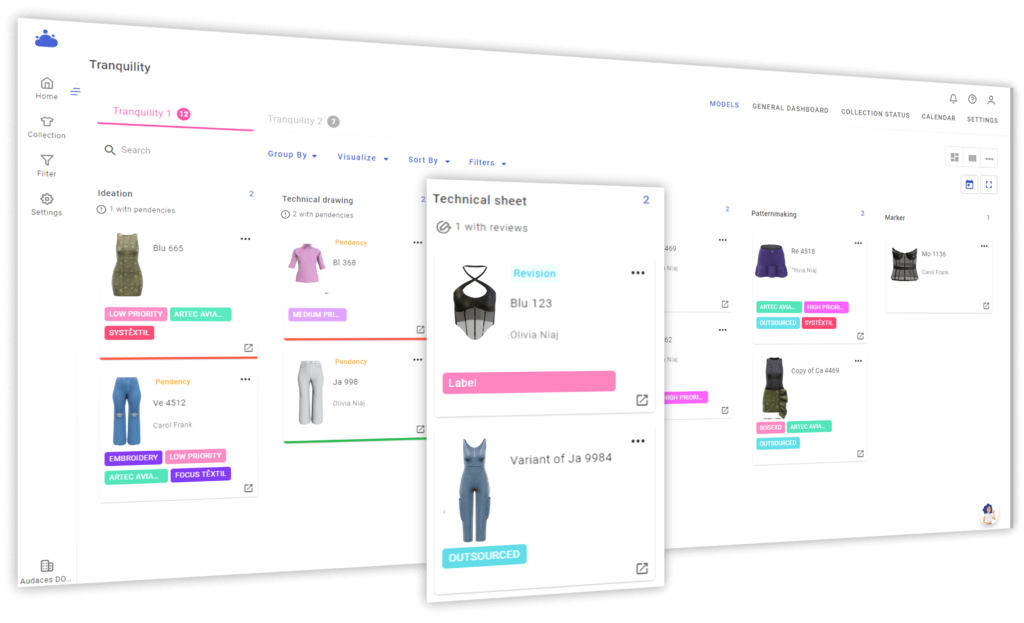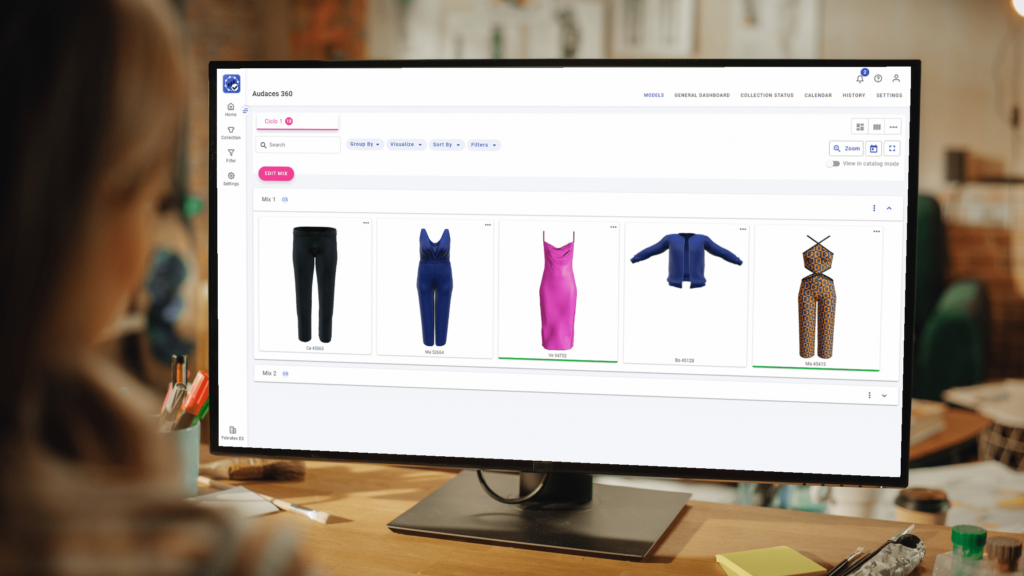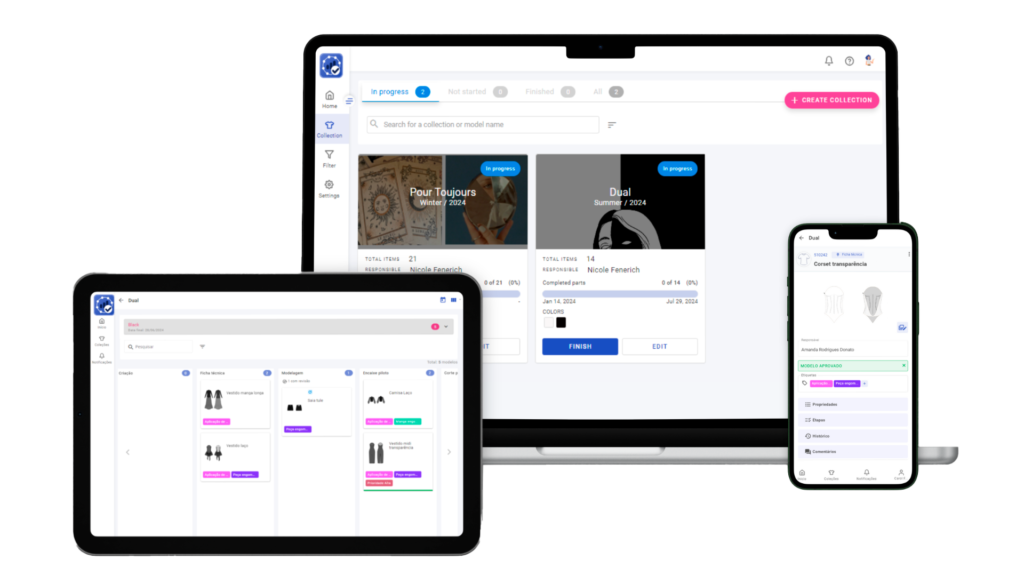Summary
- PLM is a comprehensive solution designed to manage the entire lifecycle of a product.
- Fashion businesses can streamline their operations from initial concept to final approval.
- Experience the future of the fashion industry with Audaces360 solutions. Sign up for your free trial today!
Organizing and planning your fashion business effectively is key to staying competitive. In an industry that moves quickly, having the right tools to streamline production can make a difference.
Product Lifecycle Management (PLM) is one of the most important solutions for this purpose. It enables better planning and execution of collections. This makes your business more efficient and agile.
Keep reading to discover how a Fashion PLM can help you take your company to the next level. We hope you find the information helpful and inspiring.
Happy reading!
Sumário
Why implement a Fashion PLM in your fashion manufacturing?
Implementing a Fashion PLM (Product Lifecycle Management) can transform the way your fashion business operates. It helps streamline processes, reduce errors, and improve efficiency.
This system provides a centralized place for all product data. It makes it easy for teams to collaborate and share information.
Moreover, a Fashion PLM also allows for better planning, so you can develop and launch products on time. It also enhances communication between different departments, helping to prevent delays.
With this solution, companies can respond quickly to market changes and customer demands.
It enables better resource management and eliminates unnecessary steps in the production process. This leads to cost savings and a more profitable business.
Learn more: Discover 4 essential points to thrive in clothing management
What is a Fashion PLM?
A Fashion PLM is a software solution to manage the entire lifecycle of an apparel product. It helps track every step of the creation and development process.
This system allows businesses to manage and store collection data in one place. Designers, manufacturers, and suppliers can all access the information they need quickly.
It also makes it easier to make changes and updates in real-time. This reduces errors in communication and helps prevent costly mistakes.
Overall, a Fashion PLM helps businesses stay organized, reduce time-to-market, and maintain high product quality.
Learn more: 6 benefits of having an online collection management
What are the key features of a Fashion PLM?
A Fashion PLM comes with several key features that make them valuable for businesses. They help manage product information, enhance collaboration, and improve the approval process.
Let’s take a closer look at some of the most important aspects:
Color customization
Color customization allows designers to choose colors based on trends or customer preferences.
With this feature, professionals can visualize products in various shades before production begins. This reduces the chances of mistakes during manufacturing.
Designers don’t have to test different color options by hand. It allows for quick changes and speeds up creation.
Collection management
This feature helps businesses plan, organize, and track their collections from start to finish. It brings all products in a collection together, ensuring they meet deadlines.
With collection management, you can monitor the progress of each product.
This includes tracking design, materials, and development stages. It’s easy to see what’s working and where improvements are necessary.
Kanban visualization

It provides a visual representation of tasks and workflows, making it easier for teams to track progress.
With Kanban visualization, teams can see which tasks are in progress, completed, or need attention. You can personalize the Kanban fields according to your needs.
This allows managers to prioritize work and allocate resources effectively. In addition, everyone in the project can see the status of each design, optimizing workflows.
Task automation
Task automation is a powerful feature of Fashion PLM systems. It helps reduce manual work by automating repetitive tasks.
This allows professionals to focus on more important aspects of the creation process. By automating tasks, teams streamline collection development and reduce errors.
You can set standards and improve consistency, leading to higher efficiency and quality products.
Learn more: Explore the best fashion software options for your company
Cloud storage
Cloud storage allows businesses to store and access data from anywhere. It’s especially useful for companies with multiple teams or locations.
With cloud storage, you can securely store large amounts of data. It makes it easy to share information across different departments.
This reduces the risk of data loss and ensures that everyone has access to the most up-to-date information.
Dynamic reports
They provide real-time data on the status of various aspects of collection management. You can make informed decisions and improve processes.
You can track key performance indicators (KPIs). This includes monitoring performance, reworks, delays, and productivity.
The ability to generate reports on demand allows businesses to act quickly on insights. They also help identify trends and areas for improvement.
Version history
This is an important feature of Fashion PLM systems. It keeps track of all changes made to a product’s design or specifications.
With version history, teams can see how a product has evolved over time. It also makes it easier to go back to earlier versions if necessary.
Online and real-time access
Online and real-time access allow teams to access product information instantly, no matter where they are. This feature improves collaboration and decision-making.
With online and mobile access, employees can stay up to date with the latest product developments.
This ensures that everyone is working with the most current data. It helps eliminate delays caused by waiting for updates or approvals.
Want to optimize your collection management? Our quiz will provide you with valuable insights to improve your fashion business.
How to manage a product lifecycle with fashion PLM?
Managing collections is essential for fashion businesses. It ensures that every phase is well organized. With a Fashion PLM, this process becomes easier and more efficient.
Check out the main stages of a product lifecycle:
1) Development
The development stage is where ideas come to life. Designers create sketches and concepts for new products. It’s all about creativity and innovation.
The role of a PLM is helping store and organize these ideas. Teams can collaborate and provide feedback in real time. This speeds up the process and ensures everyone shares the same vision.
Learn more: 8 tips on choosing garment types for your fashion collection
2) Introduction
The introduction stage is when the product enters the market. Marketing teams create campaigns to promote the new design. The goal is to generate excitement and attract customers.
PLM systems help track timelines and ensure the launch happens on schedule. This keeps everything running smoothly.
3) Growth
In the growth stage, demand for the product increases. Production scales up, and sales grow. It’s an exciting time but also requires careful management.
When monitoring a product’s growth, you can delve into its creation history within the PLM. This allows you to explore additional options, like color variations, to leverage its success.
Learn more: How to perform effective supplier management in fashion
4) Maturity
Maturity is when sales stabilize. It means the product is well-established in the market. Competition may also increase during this time.
In this stage, businesses often focus on maintaining market share. You can achieve it by optimizing production costs and exploring opportunities for line extensions.
5) Decline
In the decline stage, demand for the product decreases. This could be due to changing trends or new competition. Managing this phase well is important to minimize losses.
To stay ahead, it’s important to be developing new products in your PLM. This ensures you remain relevant and appealing to your audience.
What benefits can a PLM bring to your business?
A PLM system can transform how your business operates. It helps streamline processes and improve results at every stage of product development:
- Process optimization: simplifies workflows and reduces unnecessary steps.
- Cost reduction: lowers expenses by minimizing errors and waste.
- Team collaboration: connects teams for better communication and decision-making.
- Increased efficiency: speeds up tasks and ensures smooth operations.
- Faster time to market: reduces delays, getting products to customers quicker.
- Better quality control: monitors standards to deliver consistent, high-quality products.
How does a Fashion PLM help fashion companies become more competitive?

By managing tasks efficiently, PLM systems have the power to reduce time and costs. This gives companies a competitive edge.
One of the main advantages is improved organization. A Fashion PLM centralizes all product data in the same place.
Teams can access and update information easily. The result is better decisions and faster progress.
Meanwhile, it saves all your collections data, giving you the ability to generate reports and learn from past mistakes.
Learn more: How to select pieces of clothing for a fashion collection?
What should be considered when choosing a Fashion PLM?
Choosing the right Fashion PLM is an important decision. It impacts your workflow and long-term success.
Here are some tips to help you make your selection:
24/7 training and support
Training and support are essential when adopting a Fashion PLM. A well-trained team can use the system effectively. Ongoing support helps resolve issues quickly.
Look for providers that offer full assistance. This is especially important if you operate with big teams. Quick solutions minimize downtime and keep your operations running.
Choose a PLM provider that offers tutorials, live training, and a responsive support team.
Flexibility and scalability
An efficient PLM system should adapt to your business needs. Flexibility allows customization for your processes, ensuring it fits your unique workflows.
On the other hand, scalability is crucial for businesses in expansion. The solution should handle an increasing number of users, products, or data without issues.
Before deciding, consider your current needs and future plans. Choose a system that can grow with your business.
What is the best Fashion PLM on the market?

Audaces Isa
Streamline your workflow, accelerate production, and elevate your brand with Audaces Isa.
This innovative solution empowers fashion companies to take control of their entire collection development process. From initial ideas to final products.
Audaces Isa centralizes data and fosters collaboration, leading to more than a 30% reduction in product launch time. Deliver collections to market with greater agility!
You can even have real-time access to your collection’s progress directly from your phone, with the mobile version.
Identify potential issues early, track progress seamlessly, and enable teams to optimize production and quality.
Discover Audaces360 and unlock a world of possibilities for fashion management. Explore our comprehensive suite of solutions today!
FAQ
Implementing a Fashion PLM (Product Lifecycle Management) can transform the way your fashion business operates. It helps streamline processes, reduce errors, and improve efficiency.
A Fashion PLM is a software solution to manage the entire lifecycle of an apparel product. It helps track every step of the creation and development process.
Color customization, collection management, kanban visualization, task automation, cloud storage, dynamic reports, version history, and online and real-time access.










